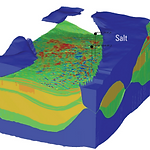top of page
Explore new frontiers of geomechanics!

Principles for Best Practice Geomechanics for CCS Injection
Operations and its Application to the CarbonNet Project
February 9, 2021 at 7:00:00 a.m.
An important element for every CCS project is the identification of subsurface injection pressure limits to ensure COR 2R retention. The purpose of the pressure limits is to protect the overlying aquifers, for surface equipment integrity, and to ensure subsurface geomechanical stability. A high confidence is required that during the operation of an injection project, any geomechanical events will be small and/or relatively localised and that adequate safeguards exist to prevent or minimise adverse events. Best Practice manuals for CCS are in development worldwide but to date no comprehensive code of practice or manual has been published.

In Search of Better Reservoir Imaging Using Fiber Optic Receivers Downhole
May 31, 2014 at 6:00:00 a.m.
For decades, the industry has worked to realize the potential of gathering seismic data in wells. But it is a hostile environment for standard equipment. An inventor has developed a fiber optic system that can handle the heat, but he needs backers to see if it can deliver in the ground.

Hybrid Microseismic and Microdeformation Monitoring of a Coal-Seam-Gas Well
October 31, 2017 at 6:00:00 a.m.
A hybrid downhole microseismic and microdeformation array was deployed to monitor fracture stimulation of a vertical coal-seam-gas (CSG) exploration well in the Gloucester Basin in New South Wales, Australia, to provide more-accurate insight into overall fracture height.

A revised age, structural model and origin for the North Pennine Orefield in the Alston Block, N. England: Intrusion (Whin Sill)-related base metal (Cu-Pb-Zn-F) mineralization
February 6, 2021 at 7:00:00 a.m.
Mineralization and associated fluid migration events in the ca 1500 km2 North Pennine Orefield (NPO) are known to be associated with tectonic activity, but the age of these tectonic events and origins of the base metal sulphide mineralization remain unresolved. New fieldwork in the Alston Block shows that mineralization post-dates a weakly developed phase of N-S shortening consistent with far-field Variscan basin inversion during the late Carboniferous.

Digital Rock Analysis of Complex Porous Media using High-Performance Computing Technology
December 9, 2020 at 7:00:00 a.m.
As the application of Digital Rock Analysis (DRA) expands in industrial and academic settings, the need for digital investigation of more complex porous media, such as carbonates and tight rocks, has increased in the market. These materials exhibit a wide range of different mesoscale properties induced by their complex, multi-scale pore structures and their connectivity. The existence of complex pore space topology and wide pore size distributions requires computations to be done at high resolutions and in a large field of view. This means that the DRA of these samples must have three essential components of "parallel computing, multiscale modeling, and process-based reconstruction of 3D volumes." These are the three main pillars of Thermo Scientific™ e-Core Software, making it a unique solution for the characterization of more heterogeneous porous materials.

Hydraulically Fractured Geothermal Well Delivers Promising Test Results
November 30, 2020 at 7:00:00 a.m.
Deep Earth Energy Production, or DEEP, says a positive well test from its first geothermal project represents a historic milestone.
The Canadian company reports that its Border-5HZ is the deepest horizontal well ever drilled in Saskatchewan and is also the world’s first 90° horizontal fluid production well to be drilled and hydraulically fractured for a geothermal power-generation application.
The initial results of the 20-stage stimulation and subsequent modeling “indicate a highly productive well—twice the productivity of an unstimulated well,” the company said in its announcement.

Old Wells Could Generate Geothermal Energy to Power Offshore Platforms
December 3, 2020 at 7:00:00 a.m.
Old offshore oil wells could be turned into geothermal energy producers under a plan by a new consortium.
The group, The Aquarius North Sea Geothermal Consortium, is “actively” working with North Sea operators to see if old wells could be used to generate geothermal energy for existing platforms. But a future goal is greenfield geothermal exploration.

Novel Solutions to Atmospheric Carbon Maintain Advantages of Petroleum
July 1, 2020 at 6:00:00 a.m.
The traditional advantages of petroleum-based transport fuels are challenged by the need to lower atmospheric carbon. Despite significant research, development, and investment during the last few decades, humanity still seeks carbon-neutral alternatives to petroleum that can be commercially viable. This paper presents novel approaches to carbon abatement using petroleum that have a strong chance to succeed in fulfilling technological and economic goals.

Geothermal Well Construction: A Step Change in Oil and Gas Technologies
January 1, 2021 at 7:00:00 a.m.
Geothermal energy has been described as an engineering problem that, when solved, provides the clean, reliable, safe, and affordable energy being sought globally. It is highly likely that the engineers who play the biggest role in solving that problem, and the technologies they adapt and advance, will come from oil and gas. There is enough energy in the earth’s crust, just a few miles down, to power all of humanity for ages, according to the US Advanced Research Projects Agency-Energy. The problem is how to tap into it safely, efficiently, and cost effectively.

+1 (587) 926-6980
Calgary, AB T3R 0K7, Canada
©2020 by PetroGem Inc.
bottom of page
























